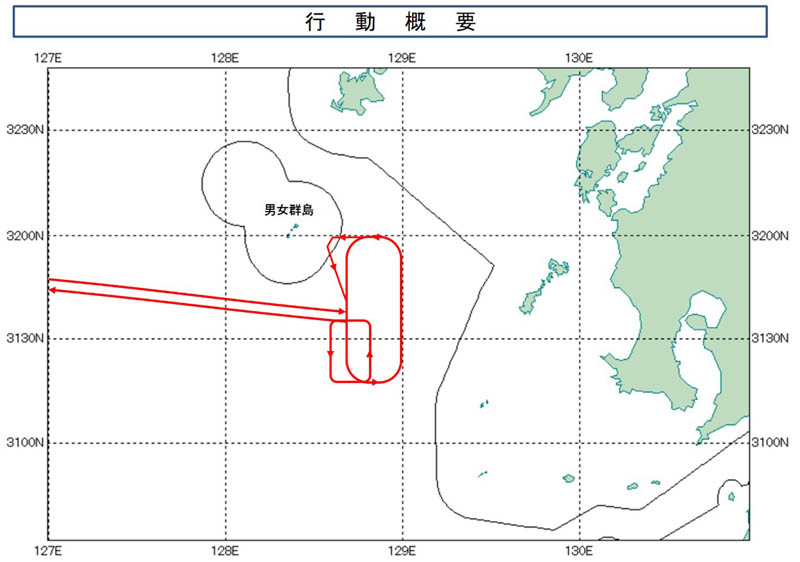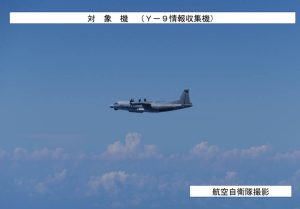On August 26, the Japanese Ministry of Defense confirmed for the first time that a Chinese military aircraft had invaded Japanese airspace.
A Chinese military Y-9 intelligence-gathering aircraft was spotted flying above Japanese territorial waters off the coast of the Danjo Islands in Goto City in the southwestern prefecture of Nagasaki Prefecture between 11:29 and 11:31 a.m. on the same day.
This was the first confirmed violation by a Chinese military aircraft since the Japan Self-Defense Forces began taking measures against airspace violations in 1958.
In a larger-than-usual response, the Japan Air Self-Defense Force (JASDF) scrambled at least four fighter jets, consisting of F-2 and F-15 squadrons from the Western Air Defense Force, which is headquartered at the Kasuga base in Fukuoka Prefecture of Kyusyu, a spokesperson at the JASDF told The Diplomat.

This map provided by Japan’s Ministry of Defense shows the flight path of the Y-9 intelligence-gathering aircraft. The red lines indicate the Y-9’s flight; the black lines mark Japan’s territorial waters.
The Y-9 is a medium military transport aircraft developed by Shaanxi Aircraft Industrial Corporation, a subsidiary of the Aviation Industry Corporation of China (AVIC). The aircraft that violated the Japanese airspace is believed to be a new variant called the Y-9Z, which is equipped with radio interception and electronic warfare equipment.
In response to the airspace violation, the Ministry of Foreign Affairs in Tokyo announced on the same day that Vice Minister Okano Masataka summoned Chinese Embassy Charge d’Affaires Shi Ying to the ministry. Okano lodged a very strong protest and strongly requested that Beijing prevent a recurrence. The Chinese side responded by saying that they would report the matter to their home country, according to the Japanese Ministry of Foreign Affairs.
This incident marked the first confirmed intrusion by a Chinese military aircraft into Japan’s airspace, but it is not the first time that a Chinese aircraft has violated Japanese airspace, according to the JASDF.
There have been two publicly announced violations of Japanese airspace by Chinese non-military aircraft, both around the disputed Senkaku Islands in the East China Sea. The islands are known in China as the Diaoyu islands.
The first incursion was in December 2012 by a small Y-12 propeller plane, operated by China’s State Oceanic Administration, and the second was in May 2017, when a small unmanned aerial vehicle, or a drone, was spotted flying on a China Coast Guard vessel that had intruded into Japanese territorial waters around the islands.
The first violation of Japanese airspace by a Chinese military aircraft was a shock for the Japanese Ministry of Defense and the Self-Defense Forces. The intrusion occurred at a time when the Ministry of Defense has been steadily strengthening its defense posture on remote islands – such as the Nansei Islands, which stretch southwest from Kyushu to Taiwan – for years.
This airspace intrusion is a historic incident that makes many Japanese think twice about the effectiveness of those measures. Is Japan’s deterrent power really working against China, which is aggressively advancing into the ocean?
Former United States Secretary of State Henry Kissinger once said, “When a country becomes rich, it must seek energy and protein.” True to these words, China is strengthening its air and naval forces and aggressively expanding into the ocean, aiming to secure resources (energy) and fishing grounds (protein).
Historically speaking, this first airspace violation by a Chinese military aircraft also shows that China is shifting its focus from land power to sea power, and thereby threatening neighboring countries such as Japan and the Philippines. Japan needs to cooperate and be more vigilant with the United States, Australia, the Philippines, South Korea, the United Kingdom, and France, among other partners.
And to avoid repeating the pattern seen in the South China Sea, where conflict between China and the Philippines is intense, Tokyo must be even more resolute in confronting Beijing’s efforts to turn the East China Sea, including the Senkaku Islands, into its own inland sea.
A previous version of this article mistakenly identified the Chinese aircraft as the Y9-JB variant.

































